Moving music off the iPod
Method I | The Apple Way
Simple ways to copy music on an iPod back to a computer's hard drive
by Christopher Breen
More iPod How To's
Editor’s Note: The following article is excerpted from the second edition of the Macworld iPod and iTunes Superguide, a 78-page, $12.95 PDF with the very best iPod and iTunes information from the experts at Macworld and Playlist. This new edition, updated for iTunes 7 and Windows compatibility, shows you how to import music from CDs, cassette tapes, and LPs, organize and manage your music files, convert DVDs for playback on a video iPod, and more. In this excerpt, senior editor Christopher Breen looks at moving copies of your music from an iPod to your computer.
When you’re in the business of writing about the iPod for fun and profit, the question most often thrown your way is: “How do I get my music off the iPod and onto my computer?”
The difficulty in answering such a question is that it may be born of less-than-honorable intent. The person asking the question may wish to learn the secret of copying music from the iPod in order to pirate music. While there may be a few bad apples in this regard, more often than not I find people ask the question to find out how to recover music after their computer’s hard drive has crashed. It’s no fun losing thousands of songs at a single bad stroke (and even less fun if a goodly portion of those songs were purchased from the iTunes Store).
Given that I’m asked the question with such regularity, I’ve decided to point the way in the hope that it will help the virtuous among us. Those bad apples intent on stealing music will find a way to do it with or without my help.
Ghostly protection
For those who aren’t hip to the current state of affairs, I should explain that in order to deter music piracy, iTunes and the iPod were originally designed so that music would travel in one direction only—from the computer to the iPod. This has now changed somewhat. With iTunes 7, when you attach an iPod you own to a computer authorized with your Apple ID, iTunes will offer to copy protected content from the iPod to your computer. But that remains the only Apple-blessed way to move music from the iPod to your computer. When you double-click on an iPod mounted on a computer, you’ll find no folder within that holds the device’s music. Yet the music has to be there somewhere.
It is. It’s invisible.
Invisible?
Yes. When Apple designed the iPod’s copy-protection scheme it did so understanding one of the fundamental laws of this new millennium: That which can be locked will be unlocked (by a 12-year-old boy).
Rather than dump millions of dollars into a complicated copy-protection scheme—which would almost immediately be broken by one of these wily 12-year-olds—the company did the wise thing and protected the iPod in such a way that honest folks wouldn’t be tempted to pilfer music off another’s iPod. The company’s engineers did so by doing nothing more than making the iPod’s music folder invisible. Therefore, the trick to getting the music off the iPod is accessing this invisible folder.
Brute force techniques
Though fairly graceless, one of the easiest ways to recover your music from an iPod is to make the iPod’s music folder visible and then drag it over to your computer’s desktop. Once there, simply add that folder (and the music within) to iTunes by dragging the folder into iTunes’ main window or using the program’s Add to Library command (found in the File menu). Here’s how to do this on either a Mac or a Windows PC.
Macintosh The Mac doesn’t include a utility for making invisible files visible so you must download one. My favorite tool for this job is Marcel Bresink’s free TinkerTool. Once you’ve downloaded TinkerTool, follow these steps:
- Plug in the iPod.
- If iTunes doesn’t launch automatically, launch it.
- If the music library on your iPod is not linked to iTunes’ music library (as would be the case when you’re restoring your music library from your iPod to a fresh copy of iTunes installed on a reformatted drive), iTunes will ask if you’d like to sync the contents of the iPod with the contents of the iTunes library. Click Cancel.
- Select the iPod in iTunes’ Source list and make sure the Summary tab in iTunes 7’s main window is selected.
- Enable the Manually Manage Music option as well as the Enable Disk Use option.
- Launch TinkerTool and click the Finder tab.
- Enable the Show Hidden and System Files option.
- Click Relaunch Finder.
- Move to the Finder and double-click on the iPod’s icon on the Desktop.
- You’ll discover that several more items now appear in the iPod window. Among them is a folder called iPod_Control.
- Double-click the iPod_Control folder.
- Inside the iPod_Control folder you’ll find a variety of folders. The one you care about is the Music folder.
- Drag the Music folder to your Mac’s Desktop to copy it to your computer. As the name implies, this is where music is stored on the iPod.
In earlier versions of iTunes you could simply drag this Music folder to iTunes’ main window and the music within it would be copied to iTunes’ music library. This is no longer the case. You must now open the Music folder, open the the folders within (these folders all begin with the letter F), and then drag the contents of the folders into the Library entry in iTunes’ Source list.
The songs you copied from the iPod will be added to iTunes. If you’re a tidy type, before copying those files to iTunes, open iTunes’ preferences, click the Advanced tab, and make sure the Keep iTunes Music Folder Organized and Copy File to iTunes Music Folder When Adding to Library options are enabled. Enabling these options will organize your iTunes library in the way iTunes prefers.
Windows At the risk of making my Windows readers feel like second-class citizens, please follow the first four steps outlined in the instructions for Mac users. Once you’ve done that:
- Double-click on the My Computer icon on the Desktop.
- Locate your iPod in the window that appears and select it.
- Choose Folder Options from the Tools menu in the My Computer window.
- Click the View tab in the Folder Options window that appears.
- Look for the Hidden Files and Folders entry. Below this entry enable the Show Hidden Files and Folders option and click Apply to reveal the hidden files.
- Dismiss the Folder Options windows by clicking the OK button.
- Double-click the iPod’s icon in the My Computer window.
- Sorry about the return to second-class citizen status, but please follow steps 8 through 10 in the Macintosh instructions above.
- Once the Music folder is on the Desktop, right-click on the folder, select Properties from the contextual menu, uncheck the Hidden option in the Attributes area of the General tab, and click Apply. In the Confirm Attributes Change window that appears make sure the Apply Changes to This Folder, Subfolders, and Files option is checked and click OK.
The folder and all the items in it are now visible and can be dragged into the iTunes library.
Note that although the music files bear a seemingly incomprehensible four-letter title (AHLK.m4a, for example) when viewed outside of iTunes, their titles will appear properly once you’ve brought them into iTunes.
More-refined methods
Scan sites such as hotfiles.com and versiontracker.com and you’ll discover that there are a host of utilities designed to pull music off your iPod and onto your computer. Some are more sophisticated than others—allowing you to copy not only the music the iPod carries, but its playlists as well. Here are a few of my favorites.
Macintosh
• Senuti: Whitney Young’s free Senuti offers a straightforward interface for moving media off your iPod. Like similar utilities, it allows you to select tracks and videos on the iPod and then copy them to a location of your choosing. Unlike with some other utilities, you can copy not only single items and songs grouped by artist and album, but also complete playlists from the iPod.
This solves a tricky problem that has plagued some iTunes users. Suppose that you lost your computer’s entire iTunes library. You could recover your songs from the iPod, but how would you re-create your carefully wrought playlists? As Senuti’s Help says:
Playlists can be added through drag and drop, too. All of the songs in the playlist will be copied to your save location, then added to iTunes. If a playlist with the name of the one you’re dropping exists in iTunes, songs will be added to that playlist. Otherwise a new playlist with that name will be created.
• iPodRip: The Little App Factory’s $15 iPodRip is another good utility. Like Senuti, it lets you recover songs, albums, podcasts, videos and playlists from your iPod to iTunes. It also supports all song information that’s stored by iTunes, including ratings, play count, and last played. iPodRip features an iTunes-like interface for easy operation. You can find a version for Windows here.
Windows
• TuneJack: If you have a Windows-formatted iPod, iPodSoft’s $10 TuneJack offers a simple wizard for transferring music and video files—including playlists—to Windows. As with Senuti, it will copy only those songs to iTunes that aren’t already in your iTunes library.
For even more features, check out iPodSoft’s $15 iGadget, which not only helps you transfer songs and videos (including playcounts, user ratings, and last-played dates) to your Windows machine, but also lets you transfer data such as e-mail, RSS feeds, notes, weather and more to your iPod.
More iPod How To's
Apple Method: Move Music From iPod to New Computer
Switch the iPod to manual update and enable disk use
The first thing you need to do is make sure have configured your iPod to enable disk use. To do this:
- Open iTunes on your old computer.
- Connect your iPod to your old computer and wait for it to appear in iTunes.
- Select your iPod on the left side of the iTunes window under the Devices section to display your iPod preferences.
- Click the Summary tab in the main iTunes window.
- Select the "Manually manage music" checkbox. This will also select Enable disk use.
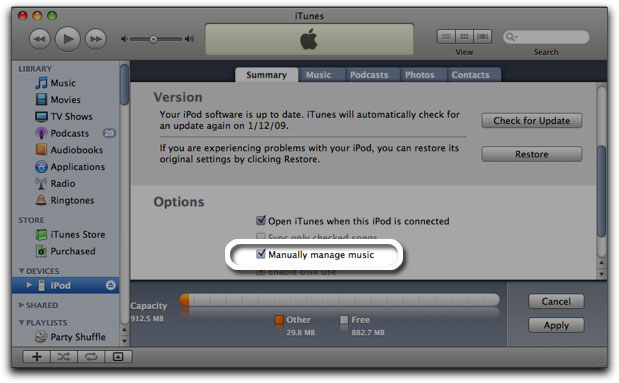
- A message appears that says:
"Disabling automatic update requires manually unmounting the iPod before each disconnect."
Click OK in the message window.
- Click Apply in bottom right of the iTunes window.
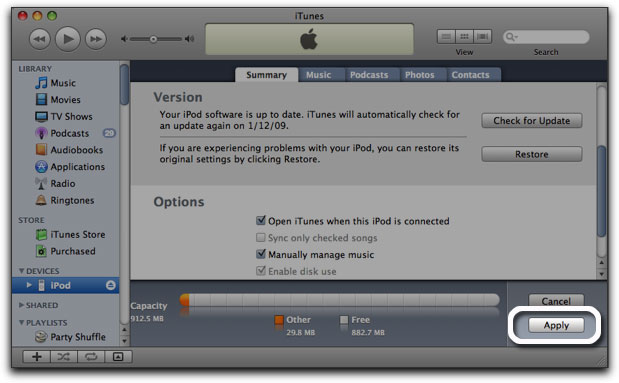
Is all the music together?
To make the move as easy as possible, be sure your music is all in one place.
- Open iTunes Preferences:
Mac: Choose iTunes > Preferences.
Windows: Choose Edit > Preferences.
- Click Advanced.
- Look to see if the checkbox for "Copy files to iTunes Music folder when adding to library" is selected. If it is, skip ahead to Is there enough room on the iPod. If it is not, continue to step 4.
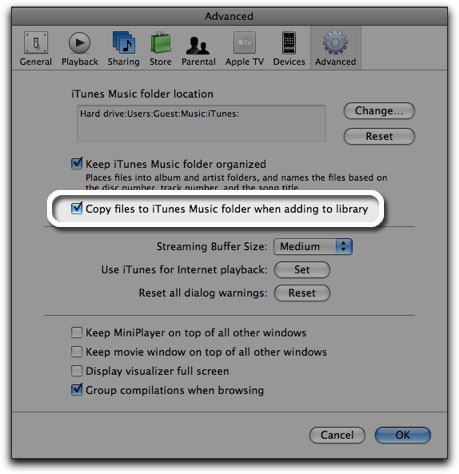
- Select the "Copy files to iTunes Music folder when adding to library" checkbox.
- Click OK. Note:
Clicking OK will cause iTunes to copy all of your music files to
another location on your computer. You will need to manually remove the
files from their previous locations if you are concerned about drive
space. If your computer does not have enough hard-drive space this
process will not work correctly. Please speak to your computer
manufacturer or Microsoft for more information on how to obtain more
space to perform this action.
- Choose File > LIbrary > Consolidate Library.
A window appears reading: "Consolidating your library will copy all of
your music into the iTunes music folder. This cannot be undone."
- Click Consolidate.
Is there enough room on the iPod?
iPod shares its hard disk space between the songs that iTunes puts
on it and any files you've added when using its disk mode. To transfer
music with your iPod, you need enough free space to hold a copy of all
your music files in addition to any copies that may already have been
placed by iTunes (this is because non-purchased songs placed on the
iPod by iTunes cannot be copied off the iPod while in disk mode). To
figure out how much space you have on your iPod:
- Open iTunes on your old computer.
- Click on Music on the left side of the iTunes window. The size of your library appears at the bottom of the iTunes window:
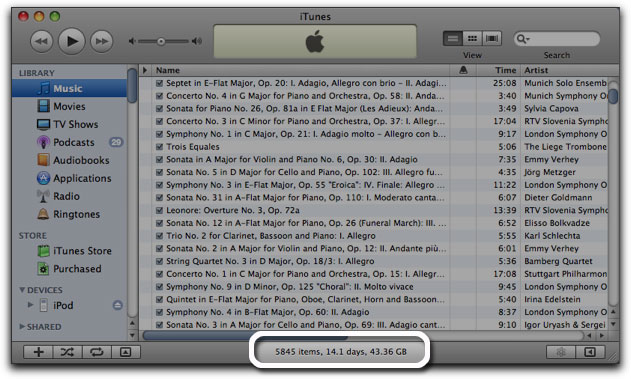
- Connect your iPod to your old computer and wait for it to appear in iTunes.
- Click iPod under Devices on the left side of the iT.
- The amount of free space on iPod appears near the bottom of the iTunes window:
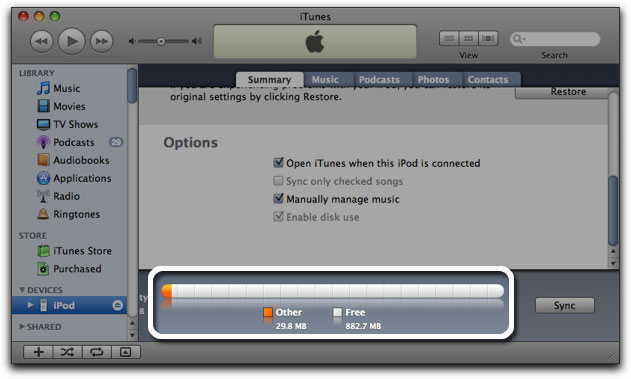
- If the amount of free space left on your iPod is larger than your library, skip to Copy iTunes folder to iPod.
Free up space on iPod
If your library is larger than the amount of free space on your iPod, you'll need to free up some space on it. Here's how:
- Click iPod on the left side of the iTunes window.
- Click
on the Music option listed under iPod. (If you do not see this option,
click the gray arrow next to the iPod to reveal the iPod's contents)
- Click any song that appears in the main part of the iTunes window (to the right).
- Choose Edit > Select All.
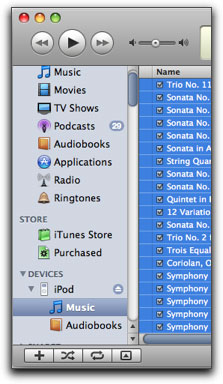
Important: The next step will delete all music from your iPod. If you have been using automatic update you don't
need to worry, because all your music is also on your computer. If you
have not been using automatic update, and your iPod has music on it
from another source (other than your iTunes library), following the
next step will delete that music.
- Press
Delete on the keyboard. If you see a message that says "Are you sure
you want to remove the selected items from the list?", click Yes.
Copy iTunes folder to iPod
To copy all your music files (including the library file that holds all your playlists and other settings) to your iPod:
- Quit iTunes.
- Locate your iPod:
Mac OS X: On the desktop
Windows: In My Computer
- Locate your iTunes folder:
Mac OS X: /Users/username/Music
Windows: \Documents and Settings\username\My Documents\My Music\
- Drag the iTunes folder to the iPod. This can take a while if you have a lot of songs.
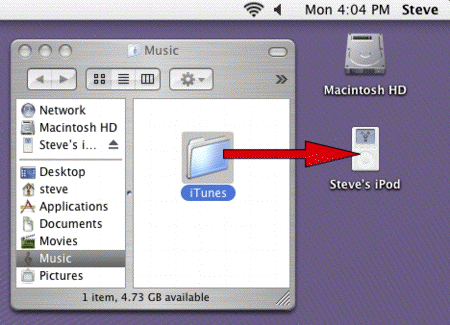
From your old Mac to the iPod
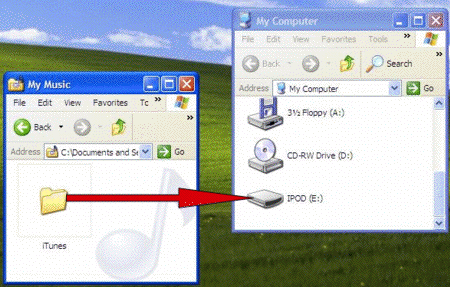
From your old Windows PC to the iPod
- When the copy completes open iTunes.
- Select iPod on the left side of the iTunes window.
- Click the Eject button to the right of the iPod icon (or choose Controls > Eject iPod).
- Disconnect iPod from the computer when the "Do not disconnect" message no longer appears on the iPod screen.
Get iTunes ready on your new computer
To get iTunes ready to accept all your music on your new computer:
- Download and install the latest version of iTunes.
- Open
iTunes on your new computer. If this is your first time to open iTunes
on your new computer you will need to choose your options in the iTunes
Setup Assistant.
- Connect iPod to your new computer.
Backup any music that's already on your new computer
Do you already have some music showing up in your Library in iTunes
on the new computer? If so follow these steps to make sure this music
gets saved (You can see how to add it back into iTunes in the Adding
music on new computer back in section below). If not you can skip down
to the Copy music to new computer section.
- Open iTunes Preferences Mac OS X:
Choose iTunes > Preferences.
Windows: Choose Edit > Preferences.
- Click the Advanced tab.
- Click
the Reset button next to iTunes Music folder location (1) and select
the "Copy files to Music folder when adding to library" checkbox (2).
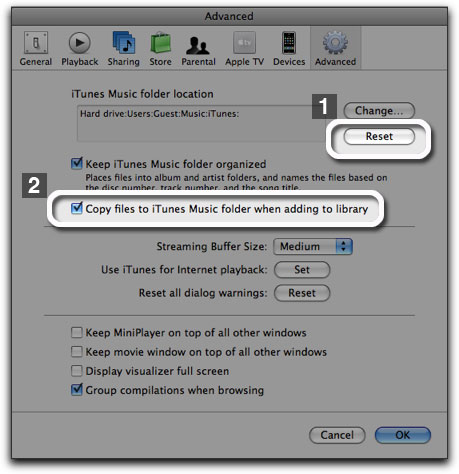
- Click OK.
- Choose File > Library > Consolidate Library.
An alert message appears: "Consolidating your library will copy all of
your music into the iTunes music folder. This cannot be undone."
- Click Consolidate.
- Quit iTunes.
Copy music to new computer
To copy all your music files (including the library file that holds all your playlists and other settings) to your new computer:
- Locate your Music folder (Mac OS X) or your My Music folder (Windows) on your new computer:
Mac OS X: /Users/username/Music
Windows: \Documents and Settings\username\My Documents\My Music\
- Drag the iTunes folder in this location out to the desktop.
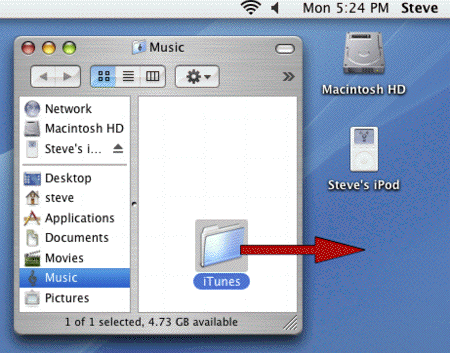
From the Music folder to the Desktop on your new Mac

From the My Music folder to the Desktop on your new PC
- Locate the iPod on the new computer:
Mac OS X: On the desktop.
Windows: In My Computer.
- Double-click on the iPod icon to open it.
- Drag
the iTunes folder from the iPod to the Music folder (Mac OS X) or My
Music Folder (Windows) on your new computer. This can take a while if
you have a lot of songs.
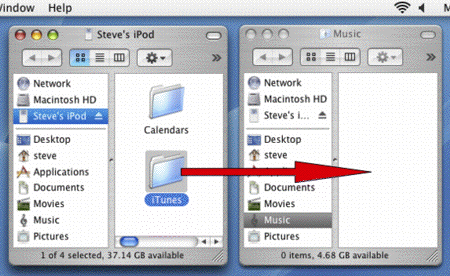
From the iPod to the Music folder on your new Mac
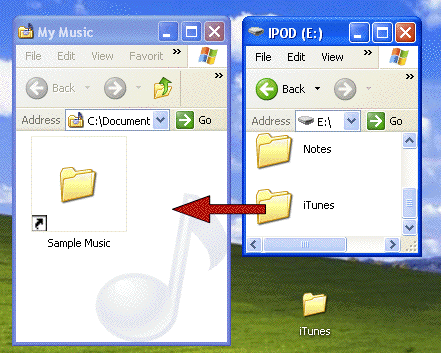
From the iPod to the My Music folder on your new PC
- Open iTunes.
There you go. All your music, playlists, and other information like
play counts and ratings have all been moved from your old computer to
your new one.
Add existing music on new computer back in
If you already had some music on your new computer, and you want to
incorporate it into the music you just moved from your old computer:
- Choose File > Add to Library (Mac OS X) or Add Folder to Library (Windows).
- Navigate to the iTunes folder on your Desktop.
- Click Choose (Mac OS X) or OK (Windows).
Note: Information like ratings and play count are not preserved for these songs.
Free up room on the iPod
To free up room on your iPod so iTunes can put all your music back on it:
- Quit iTunes.
- Drag the iTunes folder out of the iPod to the Trash (Mac OS X) or Recycle Bin (Windows).
Mac OS X: Choose File > Empty Trash.
Windows: A Confirm Folder Delete window appears. Click Yes.
Switch the iPod back to automatic update
To set up your iPod to be updated with all your music from iTunes on your new computer:
- Open iTunes.
- Select iPod on the left side of the iTunes window and click the Music tab in the iPod Settings.
- Click the “Sync music” option, and the “All songs and playlists” option. An alert message appears:
"Are you sure you want to enable automatic updating? All existing songs
and playlist on the iPod "ipod name" will be replaced with songs and
playlists from the iTunes music library."
Optional:
Uncheck the Enable disk use checkbox in the Summary tab if you don't
want to use the iPod as a disk. If you leave this option checked you
need to eject your iPod from iTunes before you disconnect the iPod from
your computer.
- Click Apply.
The iPod update begins. All your music is now on your new computer,
and after the update completes it will be on your iPod again too.
More iPod How To's